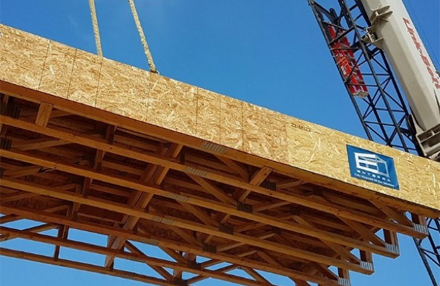
Wood is definitely the material of the 21st century – reusable, with benefits beyond lightness and ease of use such as health and wellbeing. That was a key message from Duncan Mayes, head of innovation and emerging business at Timberlink, to the Frame Australia Timber Offsite Construction conference this week in Melbourne. He was speaking on wood as the sustainable solution to tackle global challenges. Source: Philip Hopkins for Timberbiz
Mr Mayes said wood had a clear role to play in the transition to the circular economy. The topic was relatively new in Australia, but in construction, it would become a requirement. “The end-of-life factors of material and the construction method will be taken into account,” he said. These factors would be dealt with in the design stage.
“We need to ensure what we leave for our grandchildren will not cause significant challenges,” he said.
Mr Mayes said design would include the whole life cycle of components and buildings through to disassembly and re-using the material at end of a building’s life.
“I will be interesting to see how reinforced concrete will deal with this challenge, as concrete as a building system is extremely challenged in terms of reprocessing and re-using, as it’s very energy intensive, especially in brownfield developments,” he said.
“On the flip side, wood-based elements and components are easy to disassemble – unscrew, reposition, relocate and reuse.”
This put wood in a very strong position in the circular economy, but more education was needed on this in Australia.
Mr Mayes said another influencing factor was the energy efficiency of buildings. He showed a thermo-image of old terrace housing in Britain, where red hot spots pointed to where the energy was leaking out.
“Traditionally up to 45% of the heat loss in buildings has gone through those poorly insulated walls and rooves,” he said. In the past 10-15 years however, initiatives in the UK had led to the use of far more thermally-efficient window systems, resulting in improvements to overall building performance.
Mr Mayes, who has been in Australia for six months, said there was less focus on thermal insulation here. Given the large climate extremes in Australia, with temperatures ranging from 45-degrees Celsius down to cold Melbourne winter days of 5-10 degrees, “we need to be able to rethink the way the buildings are built, and the functionality of walls and rooves”.
After a small experiment, he was almost shocked at the inefficiency of the aluminium window and doors in his new apartment in Bayside Melbourne.
Mr Mayes started measuring the surface temperature performance of his window and door frames. The lowest temperature was 13deg C and the highest temperature was 56deg C on the surface of his aluminium frames.
“It’s logical – aluminium has a thermal rating of more than 200 times of wood, so it’s obvious the temperature of both cold and hot will transfer through this material unless there is an efficient thermal break,” he said
Even with double glazing, the weak point became the frames and the sashes. “I can’t comprehend these frames are allowed to be used when you need thermally efficient buildings. There is a definite need to improve on that front,” he said. “Wood is an excellent insulator.”
Solar shading was also limited in Australia, but our forefathers did understand how to build based on climate conditions. “The Queenslander is an excellent example of a building design and structure,” he said.
It took the climate into account, focussing on solar shading, natural ventilation – no need for expensive energy-using air-conditioning – and used natural renewable wood materials helped to buffer energy and moisture.
“It’s exciting to have architecture that looks different, but you need to look at the macro-climate environment and how best to design,” he said.
Mr Mayes said research that had been evolving in the past few years showed wood’s benefits for health and wellbeing in buildings. The research focussed on temperature and thermal comfort, humidity, acoustics and aesthetics – the primary factors influencing wellbeing. “We spend 80%-90%of time inside a building so we need to feel comfortable inside buildings,” he said.
A study in Slovenia, Finland and Norway found that natural softwood materials and stone were rated continuously by consumers as having the highest “naturalness” rating. Plastic and steel were at a low level, while MDF and some engineered wood products such as particleboard were in the middle, although there were some variations in cultures and nationalities.
Mr Mayes said the love of ‘naturalness’ was due to urban society feeling more and more separated from nature. These trends were also found in Planet Ark research into consumer feelings towards materials.
“Wood comes out well, in terms of a cosy environment, visually appealing, etc, so we have a lot of potential benefits of wood in terms of appearance,” he said.
Mr Mayes said very interesting work was being done on some of the components in wood, such as natural antioxidants. Research was showing that on a wood surface, ecoli and bacteria died relative quickly compared with ceramic, glass and plastic. “Wood has some active functionality,” he said.
Wood also had certain acoustic properties.
“Due to the cellulite nature of wood, it works as a sound absorber. It operates well at medium to high frequency level, such as a voice,” he said. However low frequency noise such as external traffic required a higher mass. “We need to combine these – high density material for low sound and using wood with cellular properties in the high frequency sounds,” he said.
Mr Mayes said there was research into moisture buffeting and keeping surfaces clean. Work in Finland was developing the next generation of coatings for wood, which will create resistance both to liquid water from going into the wood and humidity being absorbed in and out of the wood, he said.





